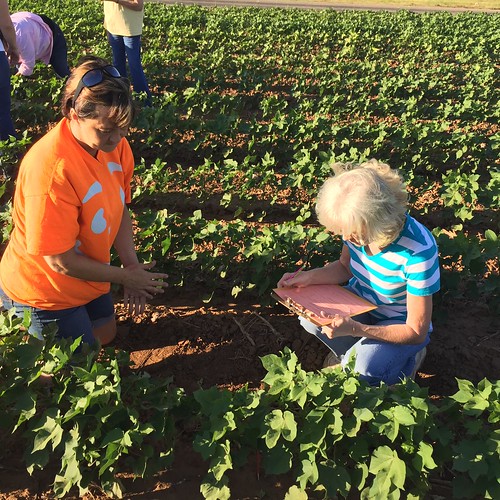
NASS interviewers conducting objective yield measurements in a field near Lubbock, Texas.
Lone Star state growers are responsible for 56 percent of the U.S. acres planted to cotton and about 45 percent of the total cotton production. But how do we measure this crop accurately enough to make dependable forecasts for cotton yield and production? That’s where our measurement process, known as the objective yield kicks in.
All of the objective yield measurements are done by a well-prepared team of National Agricultural Statistics Service (NASS) enumerators. For this growing season, we spent the week of July 12-14 training 43 enumerators with a combination of classroom and hands-on field practice. Since approximately 63 percent of the Texas crop, which represents 30 percent of the U.S. total cotton crop, comes from the High Plains of Texas, this group has the bulk of the samples in Texas.
Once we begin collecting data, these agency representatives lay out approximately 525 plots in cotton fields. Each objective yield sample will consist of two units per field, which, when combined, cover about 83 square feet of land. While this may seem like a small area, when combined across all of the plots in the state, this scientific process is quite accurate. We expect each one of these samples to represent nearly 10,500 acres of cotton grown in Texas.
Of course it takes more than one measurement to get an accurate yield and production estimate. Our enumerators return to the plots each month to collect updated data. During their visits, the enumerators count plants and fruit in a 10-foot area and pick cotton samples once bolls open. The cotton samples are weighed and sent to our National Operations Division in St. Louis, Missouri for further analysis. We also count squares, blooms, and large and small bolls from a separate 3-foot count area.
The data we collect from these plots, combined with the information growers provide in our monthly Agricultural Yield surveys, become the key source for Texas production forecasts throughout the growing season. The resulting cotton production data inform decisions made by traders, agri-marketers, legislators, and of course the farmers themselves. Key decisions impacting the cotton sector are usually rooted in these numbers.
This year, we will publish the first monthly Crop Production report for cotton production on August 12. After that we will continue publishing updated information each month through December. Final 2016 Texas and national cotton estimates will be available in early May 2017. You can find these and many other reports linked from the NASS Homepage.
No comments:
Post a Comment
Note: Only a member of this blog may post a comment.